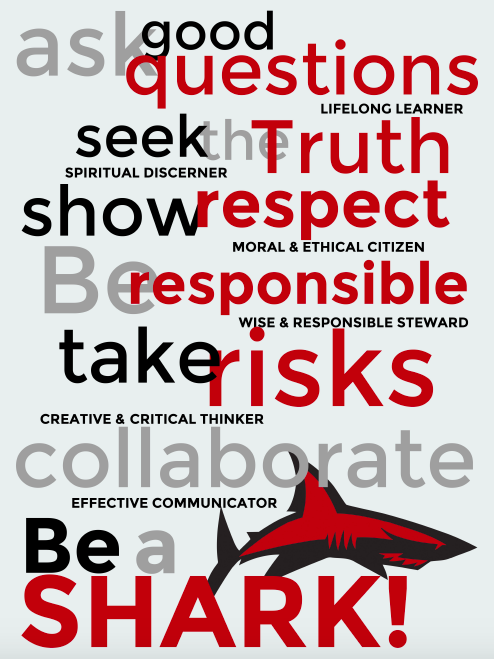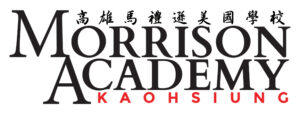The Process of Learning: Defining Engagement 學習歷程:學習投入的定義
In Separating Product from Process we looked at the value, for students, teachers, and parents, of more explicitly communicating both the what and the how of learning. Regarding the latter, I explained how MAK will be communicating process through scores in three areas: Respect, Responsibility, and Engagement. The former two categories are more familiar to us in the form of traditional participation grades, but what is engagement? What kinds of things are MAK teachers looking for?
在「由學習過程中區分出學習成果」一文中,我們看到了什麼是學習與如何學習對學生、教師與家長的價值,並更明確地傳達了二者的概念。在這封信中,我解釋了馬禮遜學校將如何透過「尊重」、「負責」與「學習投入」這三方面的成績,進而傳達學習的過程。對我們而言,上述前二者在傳統的參與分數形式中是較熟稔的。但是,什麼是「學習投入」?馬禮遜的老師希望看到的是什麼景象?

In the back of the MPR hang six large banners that communicate Morrison’s Vision For Our Learners (VFOLs). On these banners I’ve tried to communicate this vision in kid-friendly, actionable language. This same message is also communicated on posters (shown here) in every classroom in the school. Two of the six actionable phrases, Show Respect and Be Responsible, obviously link to the first two areas of the process score mentioned above. It’s the other four that communicate our idea of ‘engagement.’
在MPR後方掛著六面旗幟,分別傳達了馬禮遜對於學習者的願景(VFOLs)。在這些標語上,我嘗試著以兒童易懂的、可以用動作表達的語言來傳遞這些願景。我們也將這些訊息做成海報(這裡),張貼在學校的每間教室裡。這六個可動作化的標語中的其中兩個—「表示尊重」與「負責任」,可以與上述提及的學習歷程分數的前兩項明顯地連結在一起。而剩餘的四項則可以傳達我們對於「學習投入」的概念。
At MAK ‘engagement’ is Asking Questions, Taking Risks, Seeking the Truth, and Collaborating.
在馬禮遜,「學習投入」指的是提問、冒險、追尋真理與合作。
Asking Questions (VFOL: Lifelong Learner) 提問(VFOL:終身的學習者)
Asking questions is foundational to being a Lifelong Learner. It’s hard to imagine the real pursuit of knowledge without questions like How does this work? or How could I improve this? or Where does that come from? But while we often say we value learning, we regularly stifle it by telling our kids to bother us some other time, by fearing that if we ask questions we might look silly or uninformed, or by worrying that if we ask a question we might embarrass whomever we’re asking if they don’t know the answer. But at MAK we want kids to ask questions, whether among peers, during a lecture, while working on a project, or after class. A great learner is first a very curious person, not someone who is incredible at memorization. True curiosity is what we want to foster and in turn assess.
提問是成為終身學習者的基礎。很難想像,追求真正的知識而沒有提出像:「這是如何運作的?」、「我該如何改良這個東西?」或是「這是從哪來的?」諸如此類的問題。我們常說,我們重視學習,可是卻常常在這些情況下抵制「提問」:在孩子打擾我們的時候,告訴他們不要問問題;如果提問可能會讓我們看起來是做了件蠢事,或是表現出我們對於某件事情是不知情的;或是擔心我們問的問題,別人可能不知道答案,而我們因此感到難為情。然而,在馬禮遜,我們希望孩子們不論是在同儕中、課堂中、做計畫或是下課後都可以提問。要成為一個很棒的學習者以前,他必須先是個對事物充滿好奇的人,而不是記憶力超強的人。我們所希望的是在正道上培養真實的好奇心。
Taking Risks (VFOL: Creative and Critical Thinker) 冒險(VFOL:創意與批判的思考者)
Risk-taking in learning is when we push ourselves to do something or to think about something in a way that we haven’t before. It is the core of being creative and truly critical. Often education can feel like we are jumping through hoops, but this is often because we’ve opted for the easy, non-creative or non-critical path. When learning takes on true meaning is when we decide to try something that others wouldn’t do or that we ourselves are hesitant to do. Consider the following scenario.
在學習歷程中,「冒險」指的是我們強迫自己去做一些或思考一些以前我們從來沒做過或是想過的事情。這是創意和真正批判的核心。通常,學校教育對我們而言,我們大多只是想快點完成老師所交代的功課或任務,交差了事,這是因為我們選擇容易、沒有創意或是不受批評的途徑,而不願意自己採用冒險的學習方式。具有真正意義的學習是當我們決定去嘗試一些我們還沒做過或是我們猶豫不決的事情。一起來想一想下面的情況:
Parent: What are you working on?
Child: I’m preparing for my book club discussion on To Kill a Mockingbird. I need to figure out the theme.
Parent: I love that book! So, what do you think the theme is?
Child: Well, it looks like it is something about whether or not people are essentially good or evil.
Parent: What do you mean, ‘It looks like…?’ Wait, are you getting that straight from SparkNotes?!
家長:你在做什麼?
孩子:我在準備讀書會有關《梅岡城故事[1]》的討論。我需要把主題找出來。
家長:我很愛這本書呢!那你覺得它的主題是什麼?
孩子:嗯……這看起來像是某些關於人性本善或本惡的事情。
家長:你說『那看起來像……』那是什麼意思?等等,你是直接在SparkNotes[2]網站上直接看的?
[1] To Kill a Mockingbird 一書台灣譯名為;《梅岡城故事》,另有譯名為《殺死一隻知更鳥》。
[2] SparkNotes是美國一著名文學指南網站,建立於西元1999年。它提供了大量又免費的文學指南學習資料。
After some studying in SparkNotes, this student might be able to answer an essay question about theme beautifully on a test or to discuss it convincingly in a book club. But the how of her learning is a bit off. For one, our teacher could probably think of a better question than “What is the theme of To Kill a Mockingbird?” (I once heard a presenter say at an EARCOS conference, “If you can Google the answer, it’s probably time to think of a better question!” There is a lot of truth there!) But the student is also not trying to think about the book in a new, fresh way. There are no risks being taken. She is memorizing the recipe and never actually baking the cake.
當學生在SparkNotes上讀了一些資料後,他就可以在考試中漂亮地回答關於主題的問答題,或是在讀書會中能夠說出令人信服的想法。但是他的學習方式卻有些偏離正道。對於此一情況,老師也許可以想一想,換個比「何為《梅岡城故事》的主題?」更好的題目。(我曾在EARCOS[1]會議中,聽某個講員說過,如果你能在Google上找到答案,最好可以換個更好的題目。 他的這段話道出了很多真相。)學生也不願意嘗試用新的、不同的方式來思考這本書,這是沒有任何風險的做法。他只知道理論卻從來沒有實踐過它。
[1] EARCOS全名為East Asia Regional Council of Overseas Schools,中譯為海外學校東亞區理事會。
Willingness to take risks is easy to identify in its extremest forms like cliff diving or racing at high speeds, but it can be tricky to identify in the context of learning. Public speaking might be a big risk for some while for others it’s no big deal. As a result, accurate identification takes a caring and observant teacher who can identify which kids are truly going out on a limb, and at MAK we are blessed with teachers who truly care.
懸崖跳水或是高速賽車等極端方式能容易地看出一個人願意嘗試冒險與否,但是在學習環境上卻難以界定。公開演說對某些人來說是個很大的挑戰,對某些人來說卻不是什麼大不了的事情。因此,正確的判斷可以讓一個關心學生且細心的老師知道哪個孩子是真的正在冒險,而這樣的老師為馬禮遜帶來了祝福。
Seeking the Truth (VFOL: Spiritual Discerner) 追尋真理(VFOL:屬靈的分辨者)
Of the four categories listed here for ‘engagement,’ this is probably the trickiest to consider, or worse assess, as a teacher. In many ways this is because teachers don’t truly know what is going on inside a student’s heart! However, where I have seen this characteristic reveal itself in my students is when they begin to think bigger and deeper about course content.
在屬於「學習投入」的四個標語中,對老師而言,「追尋真理」可能是最難思考且最難評估的一項。從許多方面來說,因為老師無法真正地知道學生心裡正在想什麼。但我卻在學生身上看到,當他們開始更多地、更深地思考關於課程內容時,這個特質就會顯露出來。

In his book Naming the Elephant, James Sire attempts to define worldview as answers to eight major life questions. Our MAK version of these questions is listed on the poster pictured here, which hangs in each of our high school classrooms. Each of our school’s disciplines is essentially an attempt at exploring one or more of these questions. In math we explore the nature of the world around us. In history we explore the meaning of human history. In Bible we explore right and wrong and what happens to a person after death.
在詹姆斯塞爾(James Sire)的著作Naming the Elephant[1]中,他試著以定義世界觀的方式來回答八個與生命有關的問題。馬禮遜將這些問題的答案做成海報,張貼在高中部的每間教室裡。學校的每一條紀律基本上都是在嘗試探索這些問題的其中一條或一條以上的問題。
[1] Naming the Elephant目前台灣沒有中譯本,故書名暫不翻譯,以原文示之。
It’s when students begin making these connections – and asking about them – that they finally begin to see education as a pursuit of the Truth. Imagine our previous student passionately arguing in a discussion about how To Kill a Mockingbird reveals what it truly means to be human. That would be excellent evidence of her seeking the Truth.
當學生開始詢問這八個問題並將它們串連在一起時,最終他們會看見教育就是對於真理的追尋。想像一下我們前面提到的學生,她在討論中急切地爭論關於《梅岡城故事》一書中如何展現身為人類的真正意義是什麼時的景象。這將成為是她追尋真理的絕妙證據。
Collaborating (VFOL: Effective Communicator) 協同合作(VFOL:有效的溝通者)
According to Forbes, what matters most to modern employers even more than technical knowledge related to their field or industry is “good teamwork, decision-making and communication skills, and the ability to plan and prioritize work.” At MAK we have always valued Effective Communication, spending lots of time on reading, writing, and presenting in elementary and middle school, even requiring a double period of English in middle school. These are foundational. But also essential to being an effective communicator are the soft skills involved in collaboration with a team.
根據富比士雜誌,現今雇主們認為與該領域或產業相關的技術知識相比更重要的是「擁有良好的團隊合作、決策與溝通技巧和優先執行與計畫的能力」。在馬禮遜,我們一向重視有效的溝通,在小學部與國中部,我們花大量的時間在閱讀、寫作以及口說報告上,甚至國中部的英文課是其他課程的兩倍時間。這些都是基礎,但同時也是團隊合作中,成為有效的溝通者要素的軟實力。
I just walked through the Shark Cafe this morning to see a group of seventh graders using their core knowledge from World Geography to put together a video weather report from Afghanistan. While much of their time was spent on the content, much of it was also spent on problem-solving, assigning tasks, and trying to get it all done on a schedule. These are massively important skills.
今天稍早,我經過教師休息室前方的交誼區時,看見一群七年級生正利用他們在世界地理課中學到的核心知識,將一段阿富汗的氣象報告影片拼湊起來。雖然他們花了不少時間在內容上,但是也用了許多時間在解決問題、指派任務以及試著按照計畫完成一切上。這些都是有力的重要技巧。
Our teachers understand these skills’ importance. On Wednesday I sat through a discussion on the middle school team about how to best assess this type of collaborative work, looking at a peer assessment rubric, touching on what good collaboration looks like, and considering when it’s best for students to share in the entirety of a project versus share in only the process, not the final product.
老師們都了解這些技巧的重要性。這星期三,我在國中部參與一場討論,是關於如何能最有效地評估協同合作,觀看同儕合作評估準則,接觸到什麼是良好的協同合作,以及思考何時最好讓學生分享整體的計畫,而非只分享過程或是最終成果。
By separating these elements of questioning, risk-taking, Truth-seeking, and collaboration out from the singular grade into an engagement grade, I’m confident that we will see an elevation in awareness of their importance among our students.
將提問、冒險、追尋真理與協同合作從單一分數中分離出來,並整合放入學習投入的分數,我有信心可以看見學生們能提高對於這些技巧重要性的意識。
